Mythbusting: 3 Persistent Patek Philippe And Rolex Myths Debunked
The rise of the internet, and the consequent evolution of the watch-watching community, from its early days on forums and chat rooms into fully-fledged horology-related blogging and online retail empires, all fueled by social network apps like Instagram and Facebook, has inevitably amplified the phenomenon whereby certain objects come to exert an extraordinary hold over the collective imagination. This leads to certain watch brands becoming prized for their value as short-, medium-, or long-term investments rather than timekeeping devices. You could go so far as to regard them as a currency in their own right.
Against this feverish backdrop, rumors and legends abound. For there is no better way to boost the sale price of a vintage watch than to have it associated with a particular person or historical event. Case in point: the “Paul Newman Rolex Daytona,” which is not the same thing as the late Paul Newman’s Rolex Daytona(s), but the link is established in collectors’ minds and prices soar accordingly.
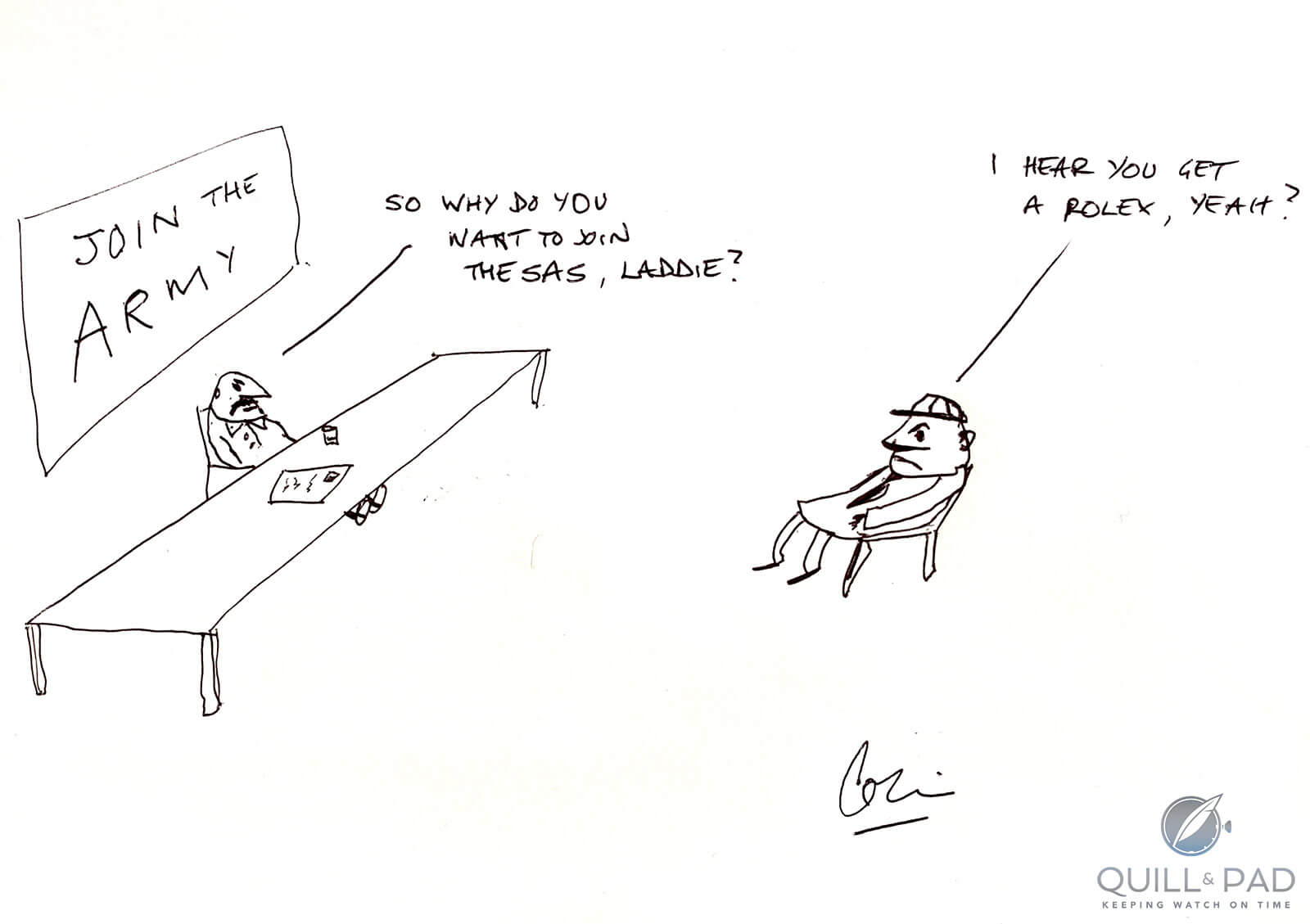
Myth Busting (sketch by Colin Alexander Smith)
Here are three watch myths circulating widely and freely online and in print, and in some cases these urban legends are brazenly perpetuated by persons and platforms who should know better.
Myth 1: Nicolas Sarkozy took off his Patek Philippe to shake hands with his supporters
Nicolas Sarkozy, president of France between 2007 and 2015, drew considerable flak from a broad section of French society for his undisguised taste for the good things in life (not to mention well-heeled personae), in particular after his post-election celebratory dinner at Fouquet’s in Paris in May 2007.
As anyone who follows both French politics and fine watchmaking may be aware, the nec plus ultra comment about Rolex watches was made by journalist Jacques Séguéla on a live chat show: responding to accusations that Sarkozy’s choice of wrist wear proved that he was the “bling-bling” president, Séguéla was simply pointing out that in the real world it’s quite normal for the president of a country to wear a Rolex.
“Why would you criticize a president for wearing a Rolex?” Séguéla postulated. “After all, everyone has a Rolex – if you don’t have a Rolex by the time you’re 50, you’re a failure.”
This statement, which was a perfectly banal and light-hearted observation, ricocheted round the media as evidence of how France’s media personalities, and by implication the president he was defending, are out of touch with “ordinary” French people, for whom a Rolex is both an unattainable object and a vulgar display of luxury.
French presidents are expected to wear a less ostentatious home-grown timepiece such as a LIP or to show support for French industry, as did Emmanuel Macron by sporting a modestly priced quartz timepiece by Biarritz-based March LA.B. Since the COVID-19 crisis, however, in ostentatious displays of media-savvy hair-shirtedness, Macron has repeatedly appeared on camera with his sleeves symbolically rolled up, wearing . . . no watch at all.
Sarkozy subsequently graduated to a Patek Phillipe, a gift from wife Carla Bruni, but the press came down heavily on him again when, in a news clip of an election rally, he launched into a bain de foule (literally a “crowd bath”) to press the flesh.
While vigorously shaking both right and left hands with admirers leaning over the barrier, Sarkozy appears to deftly whisk his Patek Philippe off his left wrist and stuff it in his jacket pocket before carrying on. Here was evidence that he clearly did not trust the people who vote for him.
In the Anglophone horological press, the incident is typically misreported, for example (the more usually accurate) Time & Tide’s, “Get your hands off my Patek . . . ” Remembering the watches and antics of Nicolas ‘Bling-Bling’ Sarkozy. This accusation is quite unfair, however, as a frame-by-frame analysis of this video filmed from a better viewpoint shows that the watch, which is on a leather strap on a deployant buckle, suddenly becomes looser on his wrist just before he slips it off and pops it in his pocket.
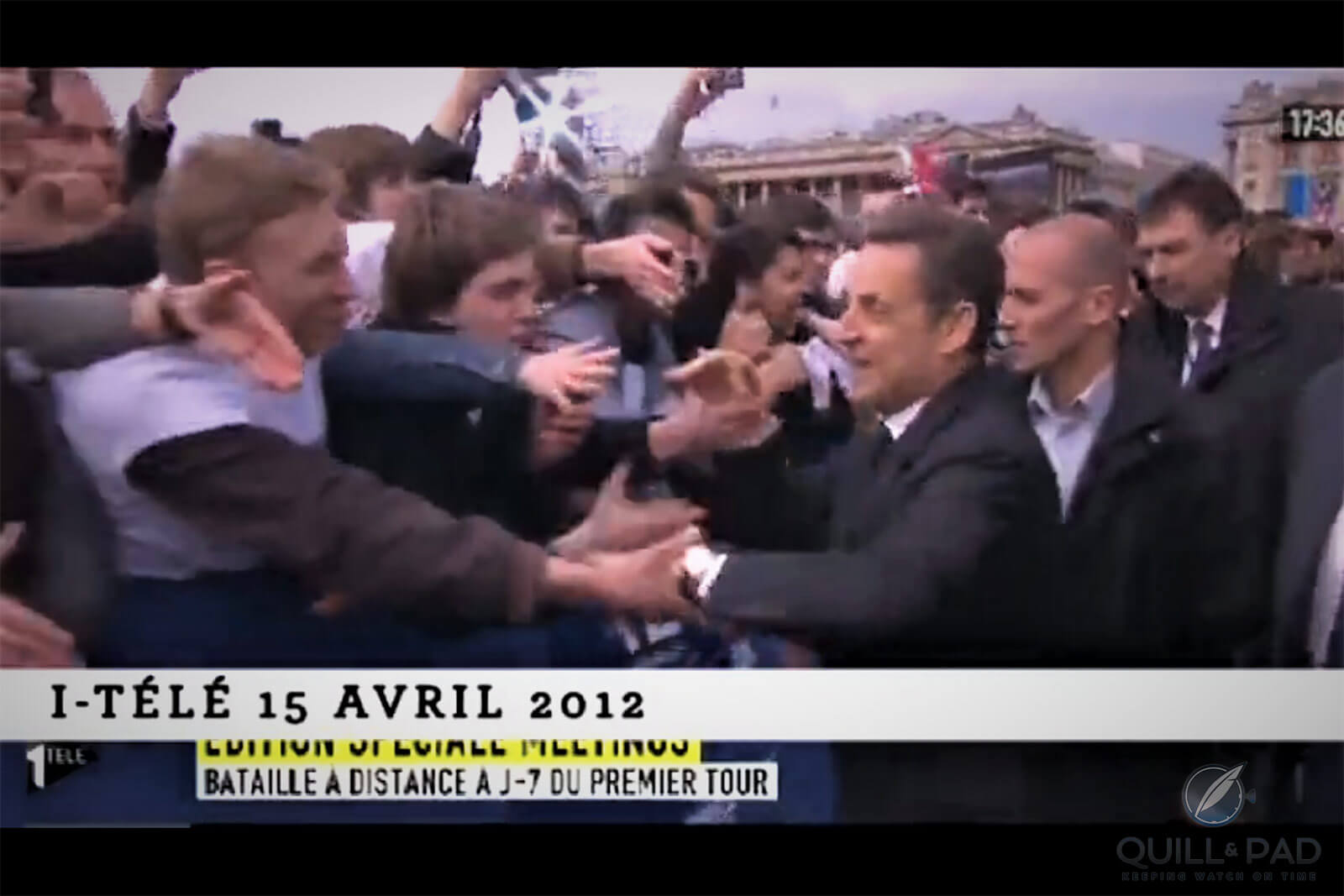
Attempted theft of Nicolas Sarkozy’s Patek Philippe on Place de la Concorde, Paris (video screenshot)
The clasp likely didn’t come loose due to the vigorous handshaking: one frame clearly shows a young man with fair hair lunging forward over the barrier, and rather than grasping Sarkozy’s hand, he has his thumb on the watch crystal, a well-known Albanian pickpocketing technique involving pinning the watch case to the wrist with the thumb while undoing the clasp with the other fingers – a method to which George Bush was reported to – though officials later denied – to have fallen victim to while meeting crowds near Tirana in Albania.
Nicolas Sarkozy was being robbed in broad daylight without his bodyguards even noticing.
With this technique, as soon as the victim feels that the bracelet has been successfully loosened, he instinctively withdraws his arm to save his watch, but the watch stays in the pickpocket’s hand. Fortunately, in this instance Sarkozy was able to save his Patek Phillipe.
Verdict: A myth. Monsieur Sarkozy is not guilty as charged.
Myth 2: the “Mirbat nine” gold Khanjar Rolex Sea-Dwellers
The second myth is one that I have to confess to having helped, at least for a time. In recent years it has become an accepted truth that “the Sultan of Oman awarded Rolex Sea-Dwellers emblazoned with gold khanjars to nine members of the British SAS who fought off hundreds of Omani rebels at the battle of Mirbat” on the southern coast of Oman in 1972. And at least one Rolex Sea-Dweller has been sold by Phillips with this description.
However there is in fact no evidence of this. The idea started life with a single article on these watches on the website of Rolex expert and dealer Daniel Bourn, Vintage-DB.com, in which he analyzed the serial numbers of known examples of the red and gold khanjar watches and conjectured, on a purely hypothetical basis, that these logo watches could have been awarded to the 90-odd SAS members clandestinely operating in Oman in the early 1970s, and the gold ones to the nine SAS men involved in the battle of Mirbat. The SAS (Special Air Service) are British troops deployed in special situations.
In my Quill & Pad article Khanjar And Qaboos Rolexes: Are They The Vintage Watch Industry’s Blood Diamonds? I quoted the Vintage-DB website as follows, “Given that the Battle of Mirbat was a pivotal moment in defeating the insurgents, and the lack of recognition given to the SAS soldiers by their own government, it is not inconceivable to think that Qaboos who had previously commissioned the Red Oman watches to commemorate the SAS soldiers who occupied Oman during the 1970-1976 campaign would commission a small special batch to honor the nine SAS troops who put their lives at risk during the Battle of Mirbat to defend Oman from the rebellion.”
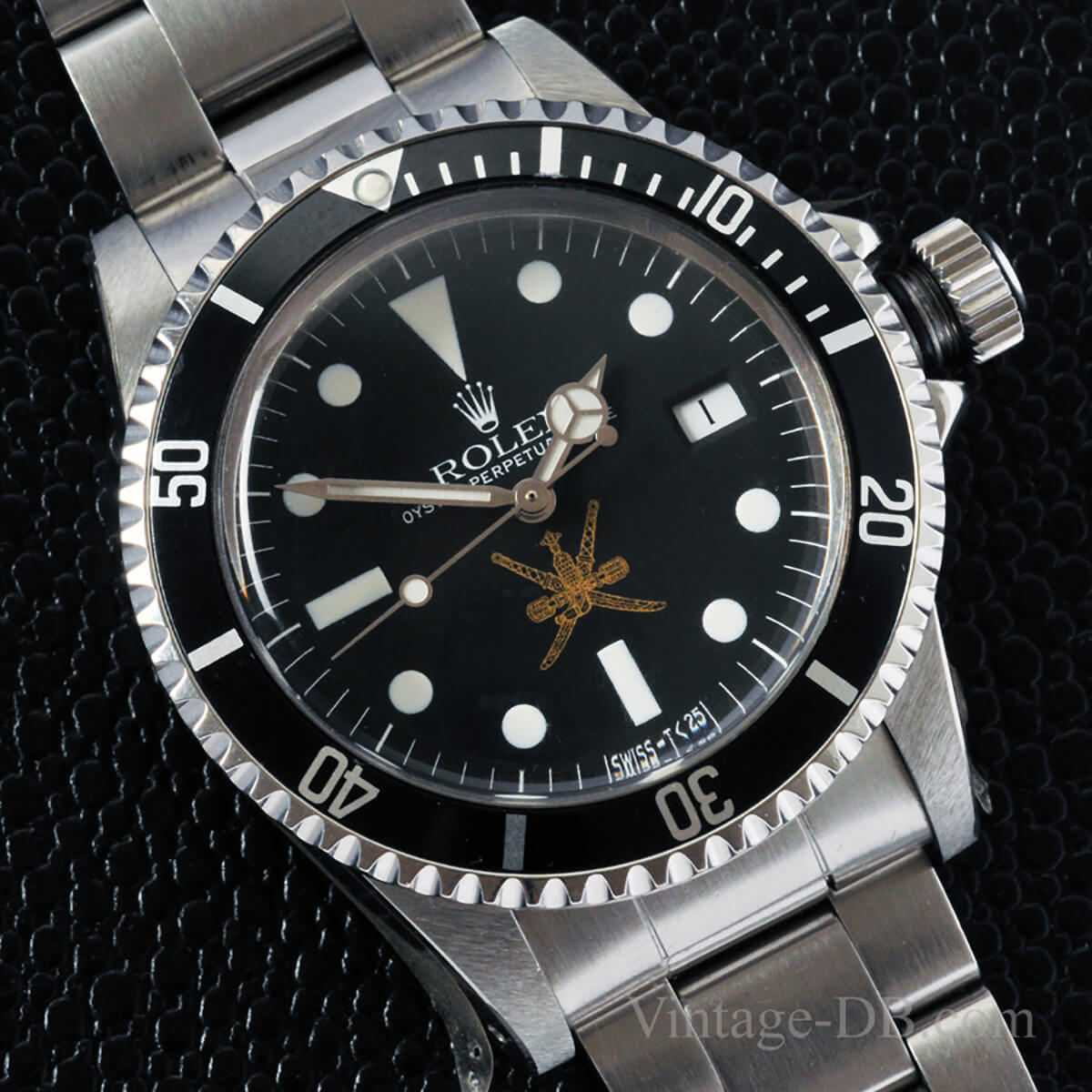
“Gold” (referring to the color of the Omani emblem) Rolex Khanjar Sea-Dweller (photo courtesy www.vintage-db.com)
Like the lost text identified by Bible scholars as “Q” (for Quelle, “source” in German), the inspiration behind the Gospels of Matthew, Mark and Luke, thus it was that the Vintage-DB website became the unintended “Q” of the Khanjar Rolex Sea-Dweller myth.
Following Quill & Pad’s publication of my Khanjar article in December 2019, a flurry of articles on Khanjar Rolexes and other watches appeared in the online and offline press, especially after the death of Sultan Qaboos in January 2020, many of which clearly drew on my article and on Daniel Bourn’s website.
For example, where my article states “this number might correspond to the nine SAS members who took part in the battle of Mirbat on 19 July 1972,” in its May 2020 article on Khanjar Rolexes, GQ magazine stated, “Recipients of these special pieces included members of the British Armed Forces, which helped the Sultanate consolidate power from the 1950s onwards. Of particular note are those presented to SAS soldiers for their help in quelling the Dhofar uprising in the 1970s.”
This highlights how a simple but attractive hypothesis very quickly morphs into fact in the mainstream media, which is in turn quoted by watch dealers and auctioneers in their product descriptions in order to drum up interest and boost prices. The circle becomes self-fulfilling.
Perhaps the parties concerned should have read to the end of Daniel Bourn’s article, where they would have read: “Of course, without official delivery information from Rolex, Qaboos, or the surviving SAS soldiers, we cannot be certain, but the theory should encourage further discussion, research, and understanding of the events in Oman during the 1970s and the important watches that commemorate the period.”
In separate confirmation of this, I asked a contact at Phillips as to whether they had handled any Khanjar Rolexes consigned by former SAS members, to which the reply was that they had sold a Khanjar Sea-Dweller but, “we only had one, consigned by the son of the original owner, but the latter was not part of the SAS.”
Furthermore, I was contacted by a London-based watch collector who had bought one of the supposed “SAS” Khanjar Sea-Dwellers and, out of curiosity, tracked down one of the SAS operatives who had actually been at Mirbat. He told me that the SAS man “laughed incredulously and replied categorically that neither he nor his colleagues received any recompense of any sort for their role in that battle, let alone a Rolex . . . ”
Myth 3 (also featuring the illustrious coronet): Sir Edmund Hillary and Tenzing Norgay were wearing Rolex watches when they reached the peak of Mount Everest in 1953
Sir Edmund Hillary and Tenzing Norgay wearing Rolex watches while summiting Everest is a dual myth that needs to be doubly scotched. No ice.
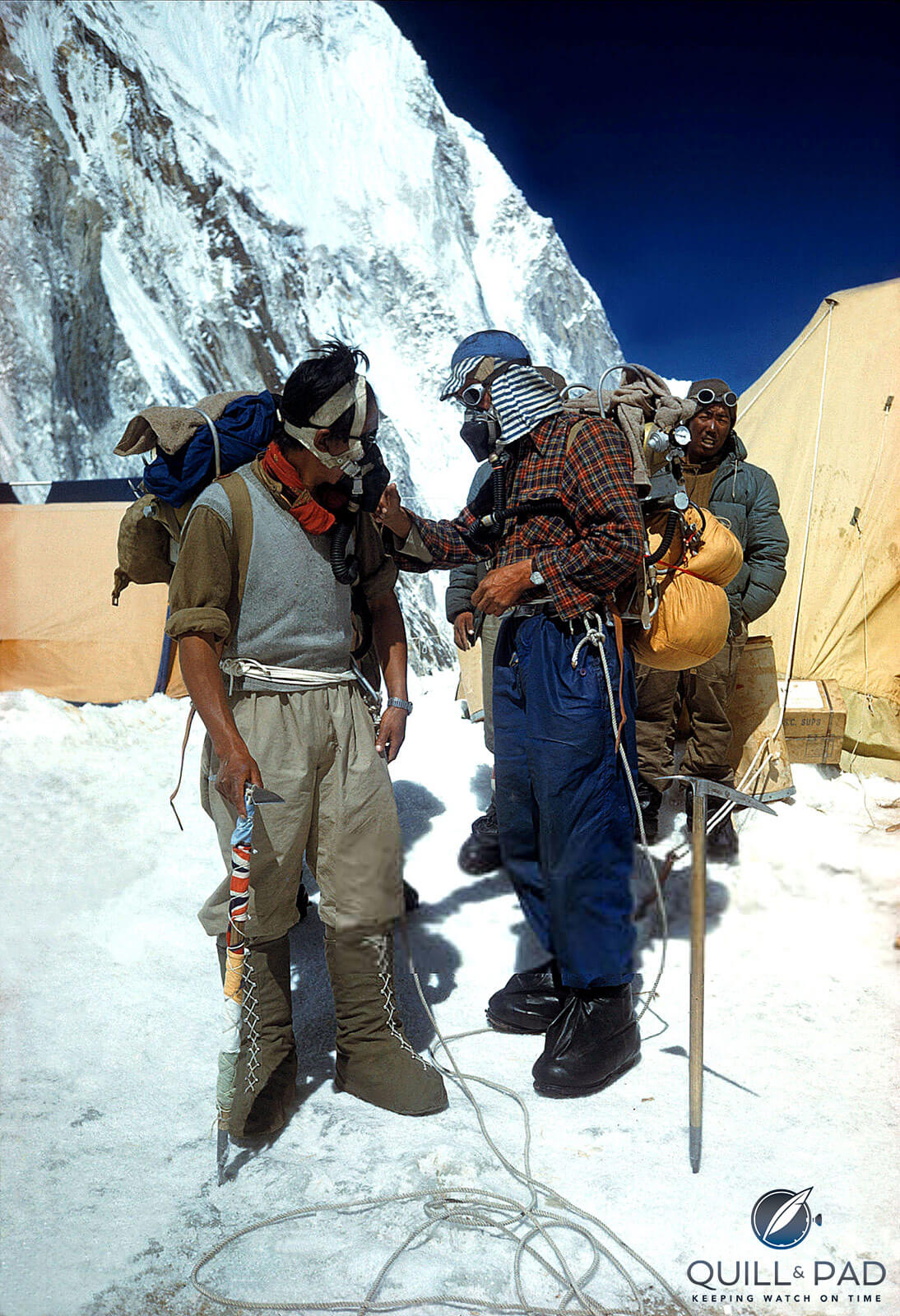
Tenzing Norgay (left) and Sir Edmund Hillary on Mount Everest Everest, both wearing watches (photo courtesy Royal Geographical Society)
The first part is easy: it is frequently claimed that Hillary and Tenzing were wearing Rolex Explorers on their conquest of the peak, or at least some form of “pre-Explorer.”
It has been clearly documented that the 1953 team led by Sir John Hunt was equipped with 13 watches from Rolex: six given to team members who had been on the previous year’s unsuccessful Cho Oyu expedition and seven for the new members of the 1953 team.
But as collector James Dowling explains in his article in the final issue of the now-defunct QP magazine, these watches were standard Rolex Oyster Perpetuals, not Explorers, as the Explorer model with its distinctive 3-6-9 dial was still in development and would not emerge in that form, with or without the Explorer name on the dial, until later in 1953. The famous Mercedes hands would not be added for another 18 months.
The second aspect of the myth is more controversial and has remained so for many years due to lack of clear photographic or written evidence. Particularly the absence of a categorical statement either way by the persons concerned or by Rolex itself. The myth perpetuated to this day by numerous print and online publications, some of which ought to know better, and backed up by a stream of almost subliminal advertisements by Rolex, is that Sir Edmund Hillary was wearing his Rolex Oyster Perpetual when he reached the peak of Mount Everest on May 29, 1953 accompanied by Sherpa Tenzing Norgay.
Sometimes the myth is extended to include Tenzing Norgay as well, claiming that he was wearing the gold Rolex Day-Date given to him by mountaineer Raymond Lambert on the Swiss Everest expedition in 1952.
For example, the following publications categorically claim that Sir Edmund Hillary was wearing a Rolex Oyster Perpetual at the peak of Everest.
Hodinkee.com: FOUND – The Rolex Sir Edmund Hillary Wore To The Peak of Mount Everest states: “In 1953, the not-yet-Sir Edmund Hillary became the first man to summit Mount Everest along with expedition partner Tenzing Norgay. And he did so with a Rolex on his wrist, an Oyster Perpetual that would prove to be the ancestor of the Explorer.”
The Watch Book Rolex by Gisbert Brunner, published by now-bankrupt TeNeues, states authoritatively that, “When Edmund Hillary glanced with a mixture of relief and joy at his wristwatch on May 29, 1952, its dial showed 11.30 A.M. . . . Like all other members of the official expedition, he had picked up his watch two months previously in Jaynagar, an Indian city along the border with Nepal, where it had been sent by Geneva-based Montres Rolex S.A.”
Phillips Hong Kong watch auction XI, November 29, 2020: “The story of the Rolex Explorer was really made when it was the very first wristwatch worn on the summit of Everest by none other than Sir Edmund Hillary and his Sherpa Tenzig [sic] Norgay.”
Online retailer analogshift.com gets it even more muddled: “The Explorer traces its heritage back to the first successful summit of Everest in 1953. While we know now that the watch on Sir Edmund Hillary’s wrist was a Rolex Oyster Precision. The Oyster Precision was the precursor to the Explorer, and it was the Precision that introduced the 3-6-9 Arabic dial that we associate with the Explorer today. It was after the successful summit that Rolex rechristened the model as the Explorer in honor of Hillary and Norgay’s historic accomplishment.”
So it is hardly surprising that, like the mist that shrouds the peak of Kanchenjunga for much of the year, the truth of the matter is shrouded in myth, which is in turn enveloped in nonsense. And the key to this mystery is encapsulated in that last sentence: “It was after the successful summit that Rolex rechristened the model as the Explorer in honor of Hillary and Norgay’s historic accomplishment.”
If Sir Edmund Hillary was wearing a Rolex (of any sort) at the summit, why didn’t Rolex re-issue a Rolex Everest in celebration of the fact, just as French watch manufacturer LIP did with its LIP Himalaya after Maurice Herzog’s conquest of Annapurna in 1954?
And why did a now-defunct English watch manufacturer by the name of Smiths issue a Smiths Everest in 1953?
Furthermore, when I interviewed professional diver Nigel Band about his father George’s Everest and Kangchenjunga Rolexes, he described attending a Royal Geographical Society talk given by Sir Edmund Hillary in the 1970s, where he overheard one of the regular society members leaning over to another member and muttering “of course it wasn’t a Rolex he was wearing at the top, it was a Smiths . . .”
Definitive answer to the Hillary/Tenzing/Rolex/Smiths controversy
Several commentators and bloggers have tried to find a clear-cut answer to this question, but after combing through all the available photographs, advertisements, and correspondence, they have usually failed to come up with a concrete answer addressing all the issues and have generally restated whichever myth they prefer to believe.
However, a definitive answer has finally emerged from outside the self-perpetuating smoke and mirrors of the watch-collecting world: an article published by outdoorjournal.com describes the background to the supplying of the expedition team with watches and other equipment, producing categorical evidence that not only resolves the matter once and for all, but ties up several loose ends and explains Rolex’s rather curious advertising strategy with regard to the Explorer model ever since.
The article can be found here, but the facts can be summarized as follows:
- Rolex was an early adopter, if not the inventor, of product placement. It had therefore already been supplying various mountaineering expeditions with a view to the publicity that would be gained by having its watches on the wrists of whoever was going to conquer Everest one day.
- Smiths was a British instrument company that had been canny enough to supply the Everest team with a range of equipment such as altimeters and oxygen regulators in addition to its watches. In return, it extracted a promise from the mountaineers that they would wear their Smiths watches to the summit.
- Rolex jumped the gun on June 2, after Times journalist James (subsequently Jan) Morris’ coded message announcing the conquest reached London, by publishing a full front-page advertisement in the Times that featured a picture of an Oyster Perpetual captioned, “The Rolex Oyster Perpetual that reached the top of Everest on May 29th.” However, this is the last advertisement or communication of any kind in which Rolex categorically claims that one of its watches had been at the top with either Hillary or Tenzing. Morris’ message did not indicate what watches they had been wearing. Interestingly, Smiths Watches placed a modest congratulatory advert on June 2 as well, followed on June 3 by a much bolder, self-congratulatory celebration of the fact that its watch had conquered Everest.
- Even though Rolex subsequently had Hillary, Hunt, and Tenzing on the payroll as brand ambassadors, the ensuing advertising is non-committal and confusing. Testimonies by Hillary and Hunt quoted in Rolex advertisements (“I wore the watch continuously, day and night”) refer to the previous year’s Cho Oyu expedition or merely praise Rolex watches in general terms.
In a typical example of this, the first advertisement for the Rolex Explorer features a drawing of two mountaineers ascending a ridge (with some way to go to the top) and a testimony from Sir John Hunt, signed on June 15, 1953, to the effect that, “Our Rolex Oyster Perpetuals were completely waterproof, unharmed by immersion in snow, and withstood the extreme change in temperature from the warm humidity of the foothills to the great cold of the higher camps.” No mention of the cold at the peak, you will note. The ad also features a picture of a black-dial Explorer, which is probably at the root of the “Explorer conquered Everest” myth. Again, circumstantial evidence but nothing that would stand up in a court of law.
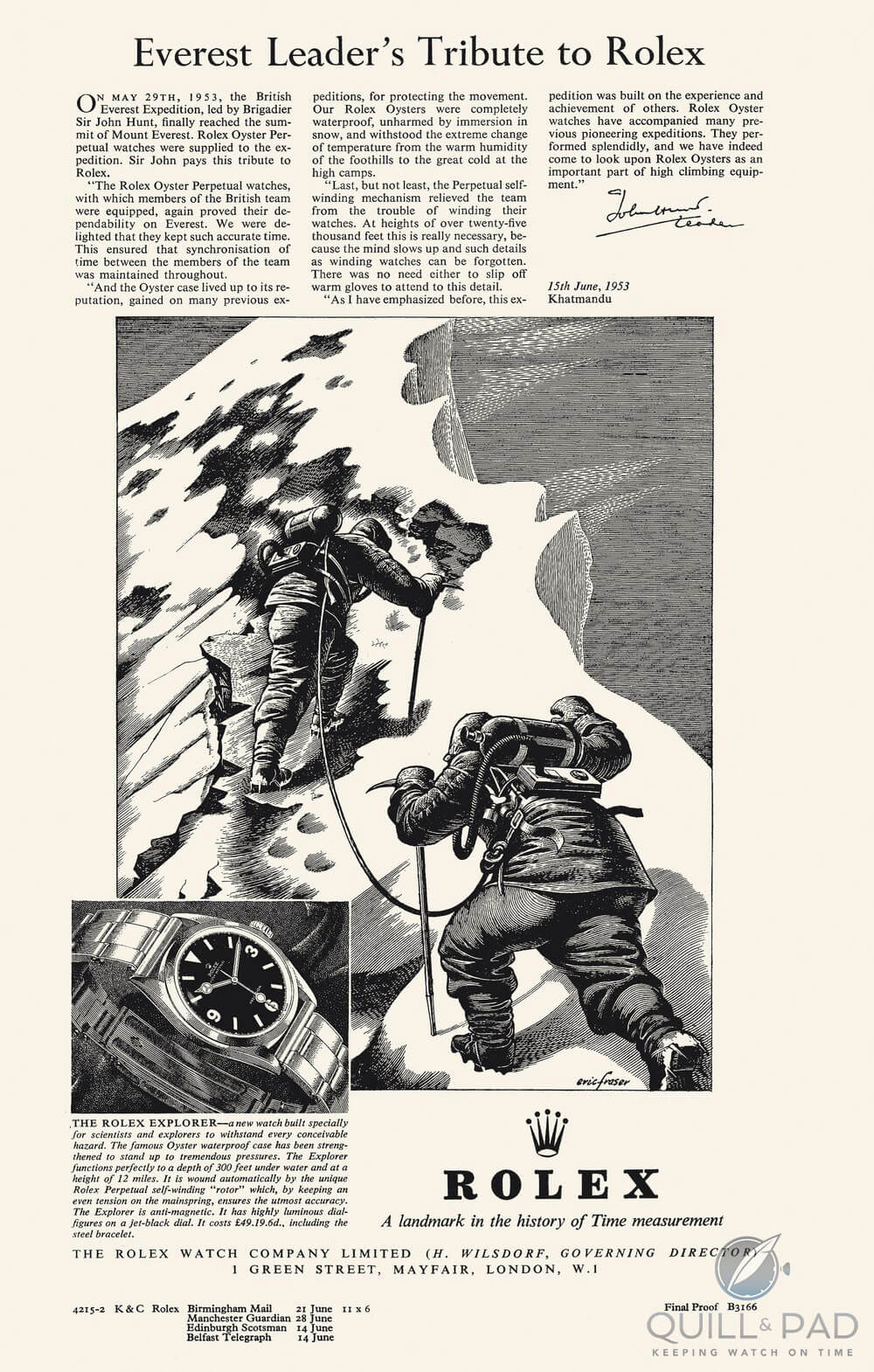
The root of the Rolex Explorer/Everest myth (historical advertisement courtesy Rolex)
In the end, it is a somewhat heated exchange of correspondence in the Journal of the British Horological Institute (as people used to do in the days before flame wars on internet forums) that categorically settles the matter.
In one letter, the managing director of Smiths English Clocks Ltd, D.W. Barrett, wrote: “Our watches, and certain other Smiths equipment including oxygen gauges, were supplied and we received a written assurance that the watches would be worn to the ultimate point reached on the mountain. Sir Edmund Hillary has stated in writing that he took a Smiths watch to the summit and no other . . .”
To which Mr. R.A. Winter, director of Rolex Watch Co., Ltd, of Mayfair, London, replied: “We supplied Rolex Oyster Perpetuals for all members of the British Mount Everest 1953 Expedition, but if by a fortuitous chance Sir Edmund Hillary’s watch did not reach him or if he was not wearing it in his ascent of the last few hundred feet, then we regret that our first advertisements in connection with Everest suggested the contrary, although we had every reason to suppose that he received his watch.
“It would appear from Mr. Barrett’s letter that Sir Edmund Hillary was, in fact, only wearing one watch at the summit and that a Smiths watch. We congratulate Smiths on the fact that their Smiths Deluxe ordinary wind wristwatch reached the summit with Sir Edmund Hillary.”
Let’s just read that again: “Sir Edmund Hillary was, in fact, only wearing one watch at the summit and that a Smiths watch.”
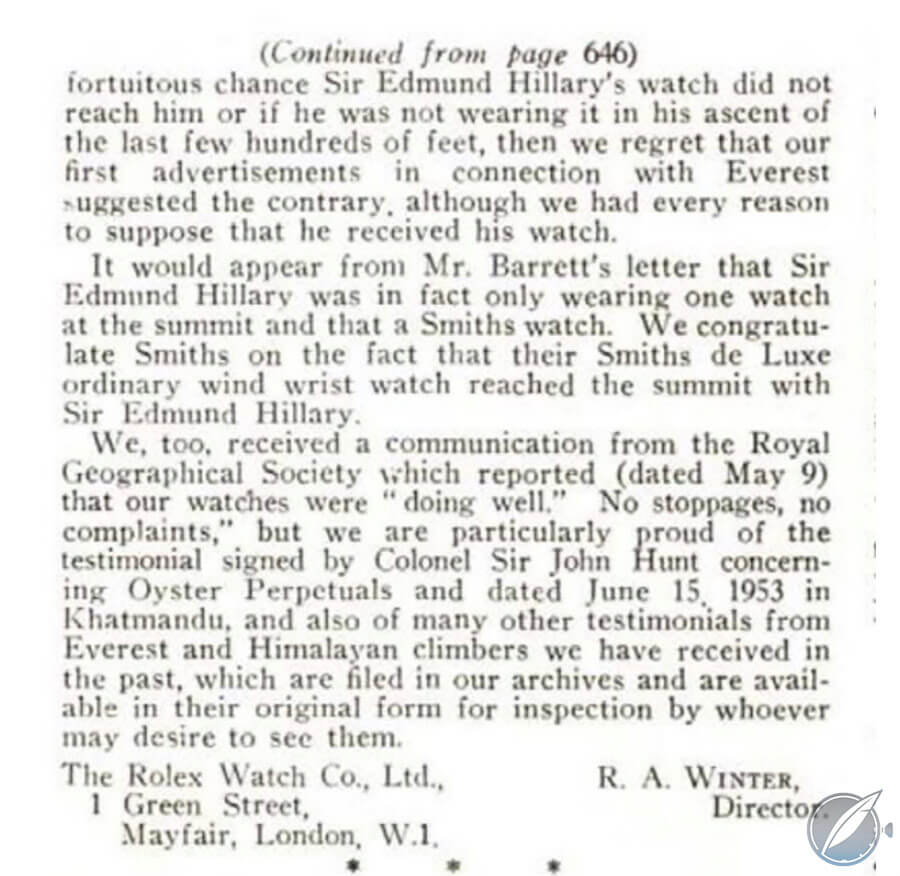
Reproduction of the BHI Journal page on Edmund Hillary’s Everest wrist wear (photo courtesy www.outdoorjournal.com)
Everything that Rolex subsequently produces in terms of advertising and communications is hamstrung by the fact that although 13 Oyster Perpetuals did go up Everest on that expedition, including two on the wrists of Charles Evans and Tom Bourdillon, who made the first attempt, turning back just 70 meters from the peak due to oxygen problems, none of them made it to the top. Now that we know this for sure, Rolex’s marketing of the Explorer model and all the subsequent advertisements make sense.
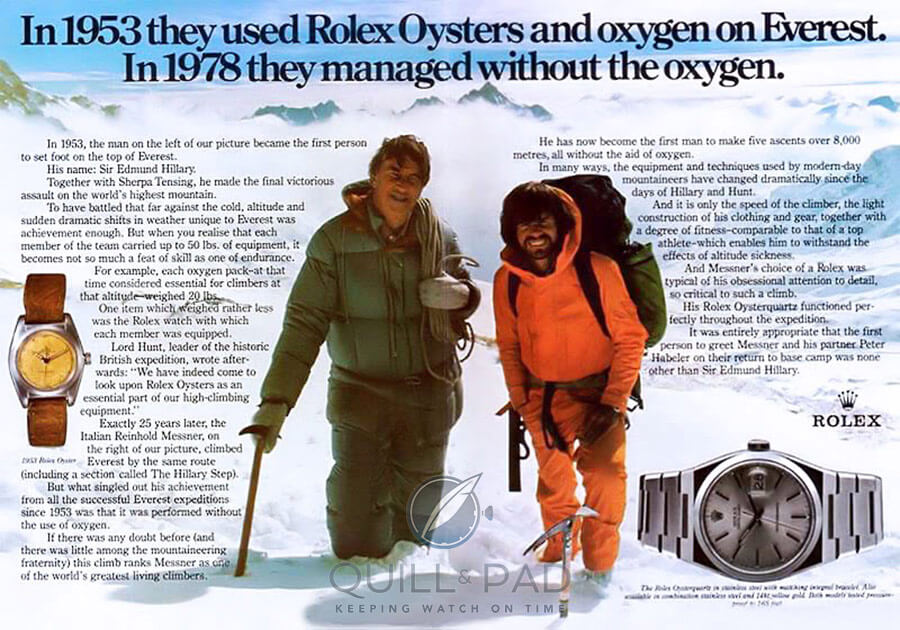
Rolex advertisement featuring Sir Edmund Hillary, which at no point states that he was wearing a Rolex at the summit of Everest (historical advertisement courtesy Rolex)

More subliminal Rolex advertising
Smiths, however, stakes its claim in no uncertain terms, even though its advertisements look amateurish in comparison to Rolex’s. Some have commented that Hillary’s statement that he “carried” a Smiths watch to the summit indicated that he wasn’t wearing it and must therefore have been “wearing” his Rolex on his wrist.
I initially thought the same thing, but have since then read several descriptions, written in the mid-twentieth century, of men “carrying” a wristwatch. Given that a gentleman carried rather than wore a pocket watch, and wristwatch production did not overtake pocket watch production until the 1940s, it is quite plausible that a man of Hillary’s generation, in a surviving vestige of common English usage, would speak of “carrying” a watch rather than “wearing” it.
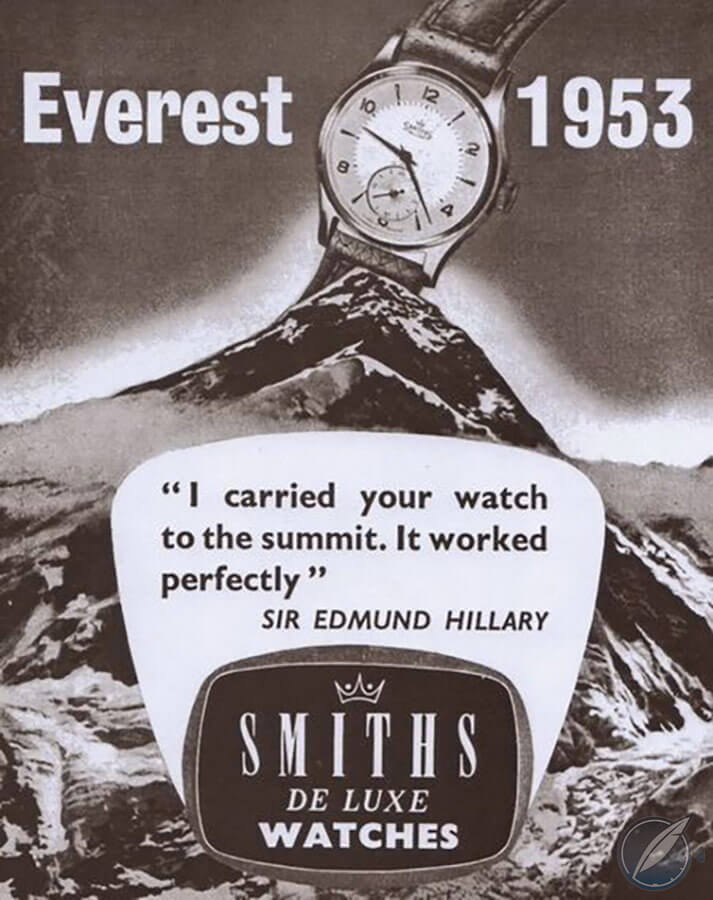
Smiths’ Everest advert (photo courtesy www.outdoorjournal com)
In any event, the Smiths watch that Sir Edmund Hillary wore to the peak of Everest is now on display in the London Science Museum.
As for the watch that Norgay was wearing, the received wisdom is that he was wearing the engraved gold Rolex Datejust given to him by mountaineer Raymond Lambert after the previous year’s Swiss Everest expedition.
However, none of the numerous photographs of him on the 1953 expedition show him wearing a gold watch. All of them clearly show a steel watch on a Bonklip “bamboo” bracelet, the type that came on the ubiquitous army issue West End Watch Co Sowar model issued to Indian and British soldiers in India for much of the first half of the twentieth century – and as would certainly have been worn by Gurkha regiments in Nepal.
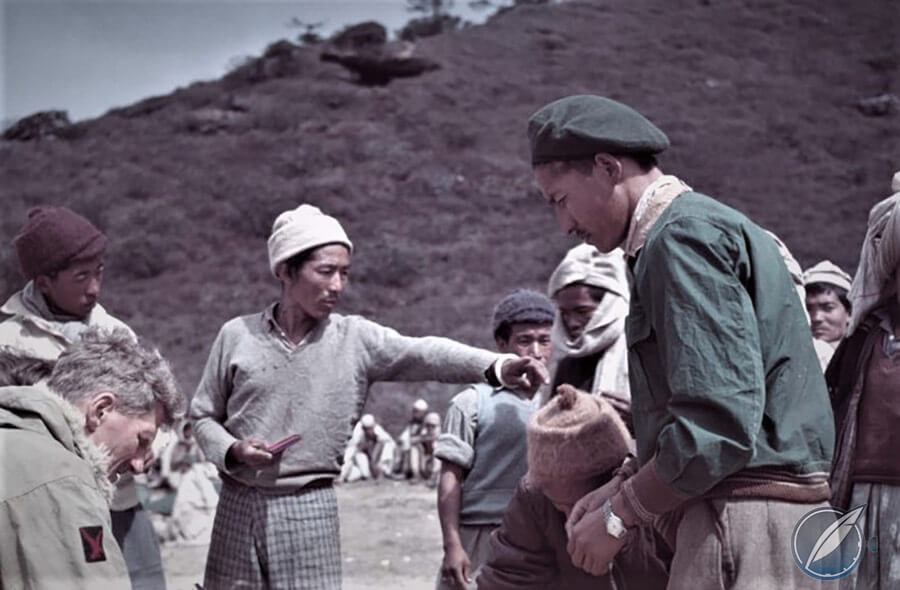
Tenzing Norgay wearing a steel watch on a Bonklip bracelet early in the 1953 Mount Everest expedition (photo courtesy Royal Geographical Society)
As you may be aware if you read my article The Grail Of Attic Finds: Reunited With The First Watch I Ever Owned, A West End Watch Co Sowar Prima, I am a fan of the Sowar and I would be delighted to think that Sherpa Tenzing Norgay was wearing one at the peak of Everest. Perhaps it was one of the Smiths Deluxes lent to the expedition, put on a Bonklip bracelet as Tenzing would have been aware of the strength, easy adjustability, and extreme comfort in hot weather of these rather unassuming-looking bracelets.
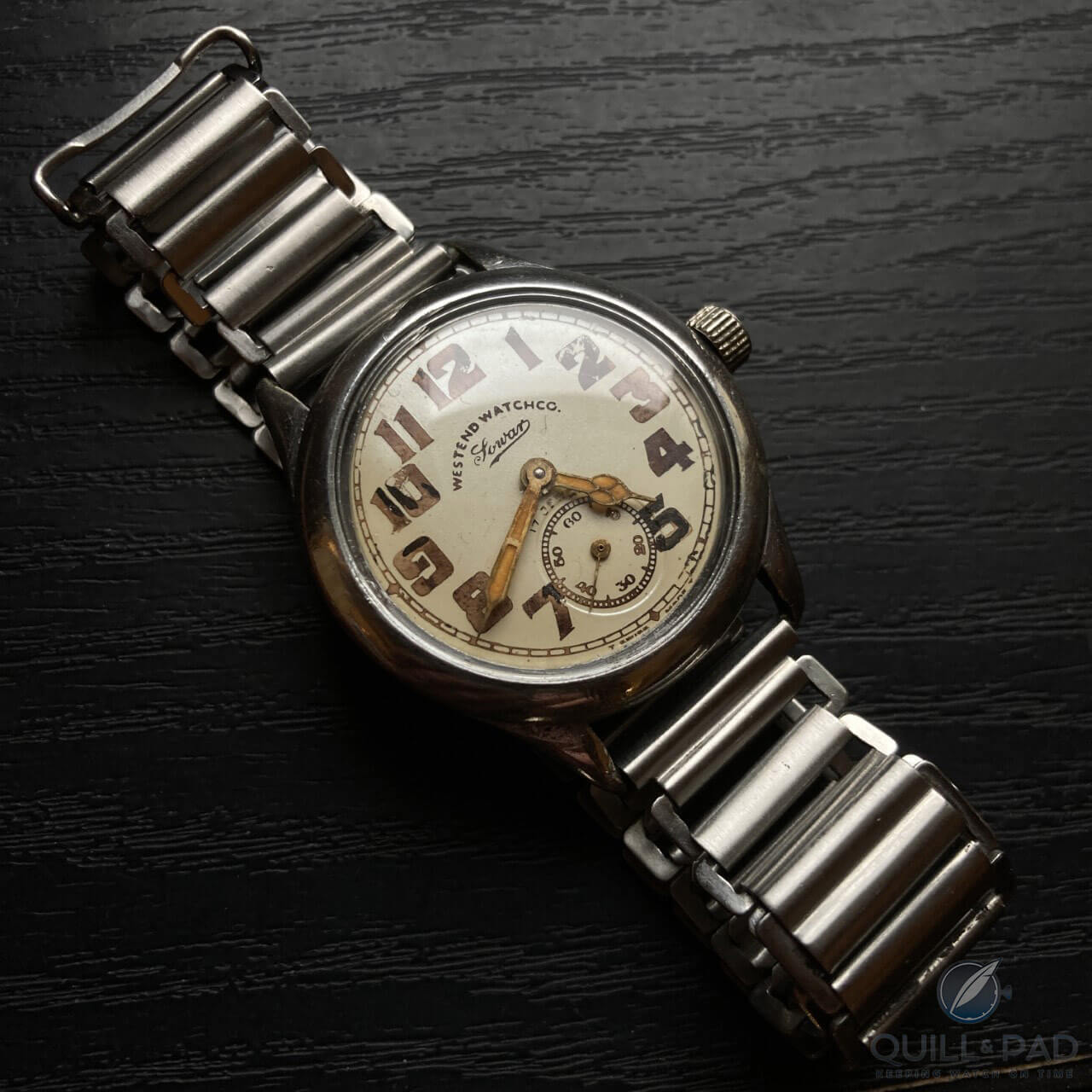
Typical 1940s West End Watch Co. Sowar on original Everbright bracelet, ubiquitous in India during this period – this example was found in Pakistan (photo courtesy Colin Alexander Smith)
If it was a Rolex, the brand would have established this fact when it debriefed future brand ambassadors Hunt, Hillary, and Tenzing after the descent and would have exploited it to the fullest. In any event, only 13 Oyster Perpetuals were supplied by Rolex to the Everest team for the 1953 expedition, and at that point Norgay did not count among the original 13 team members.
So there we have it. Rolex eventually acknowledged in writing that Sir Edmund Hillary was wearing his Smiths Deluxe, and only his Smiths, at the peak. And although Tenzing Norgay owned a gold Rolex given to him by Raymond Lambert in 1952, there is plenty of evidence in the color photographs of the Royal Geographical Society archives that he was not wearing it at any point on the Everest mission.
Unless somebody has evidence to the contrary . . .
* This article was first published on January 23, 2021 at Mythbusting: 3 Persistent Patek Philippe And Rolex Myths Debunked. You may find some of the comments under that article interesting.
You may also enjoy:
Hello, Newman: A Collector Looks Askance At The Cult Of The Paul Newman Rolex Daytona
Khanjar And Qaboos Rolexes: Are They The Vintage Watch Industry’s Blood Diamonds?
Leave a Reply
Want to join the discussion?Feel free to contribute!



Oh rolex, you continue to this day to care more about your marketing than anything else, even at the expense of having any watches in any of your stores. Pathetic! What’s more pathetic is that it appears to work! You create a demand through a specific form of marketing and advertising, including your choice of brand ambassador, without providing a product, except to those you strategize through your own company stores and ADs. It’s remarkable actually. You market and create a demand for false scarcity!
Very well said!
“The Illustrious Crown”?
I wonder just how much blame can be laid at the feet of watch media for the current state of affairs in the industry. I mean, it seems that the answer to every single horological question is “Rolex”, according to numerous websites.
It really gets my goat!